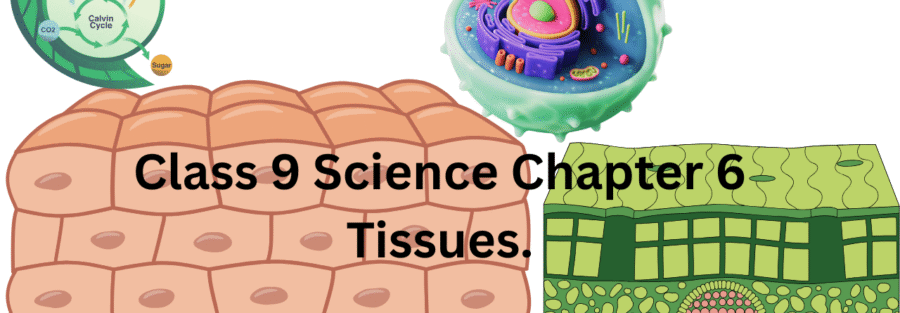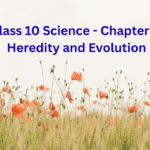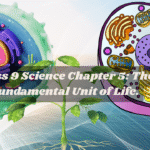Class 9 Science Chapter 6: Tissues.
Chapter 6: Tissues – Short Notes
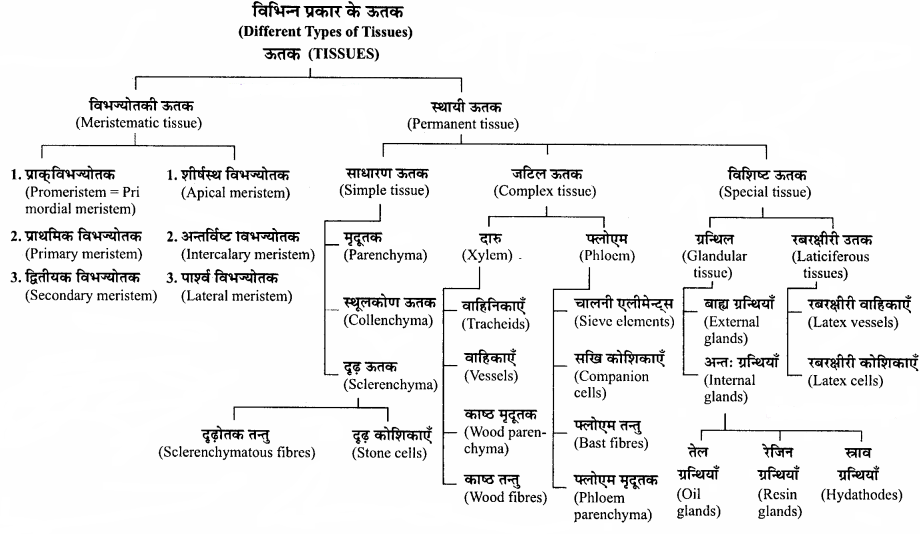
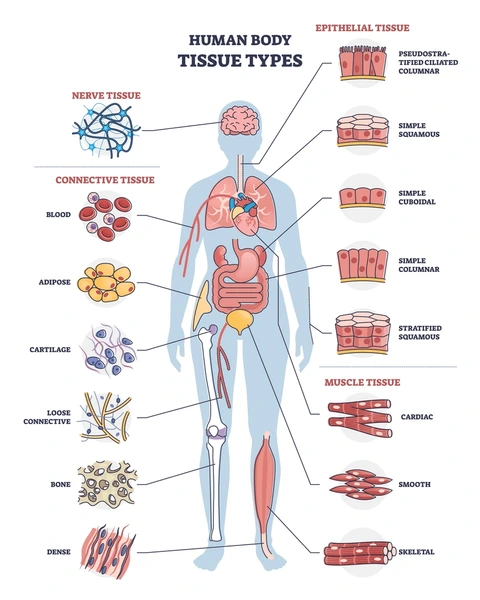
1. Introduction
- A tissue is a group of cells that are similar in structure and/or work together to achieve a specific function.
- Unicellular organisms (e.g., Amoeba) perform all functions with a single cell.
- Multicellular organisms have division of labour. Different groups of cells (tissues) take up different functions.
2. Plant Tissues
I. Meristematic Tissue
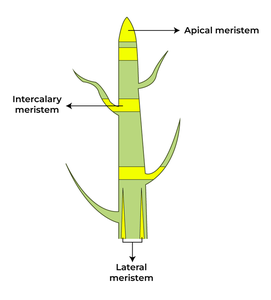
- Characteristics: Cells are small, thin-walled, isodiametric, with dense cytoplasm, large nucleus, and no vacuoles. They have the power to divide.
- Types based on location:
- Apical Meristem: Present at the tips of roots and stems. Responsible for increase in length (primary growth).
- Lateral Meristem (Cambium): Present on the sides of roots and stems. Responsible for increase in girth (secondary growth).
- Intercalary Meristem: Present at the base of leaves or internodes. Responsible for the growth of leaves and internodes.
II. Permanent Tissue
Cells that have lost the ability to divide and have attained a permanent shape, size, and function.
- A. Simple Permanent Tissue (Made of one type of cells)

- Parenchyma:
- Structure: Living, thin-walled, loosely packed cells with large intercellular spaces.
- Function: Storage, photosynthesis (chlorenchyma), buoyancy (aerenchyma).
- Collenchyma:
- Structure: Living, elongated cells with thickened corners. Provides flexibility.
- Function: Provides mechanical support and flexibility to plant parts (e.g., leaf stalks).
- Sclerenchyma:
- Structure: Dead, long, narrow cells with thick, lignified walls. No intercellular spaces.
- Function: Provides rigid mechanical support and strength to the plant.
- B. Complex Permanent Tissue (Made of more than one type of cells; conducting tissue)

- Xylem:
- Function: Conducts water and minerals from roots to other parts of the plant.
- Components: Tracheids, vessels, xylem parenchyma, xylem fibres.
- Phloem:
- Function: Transports food (sucrose) from leaves to other parts of the plant.
- Components: Sieve tubes, companion cells, phloem parenchyma, phloem fibres.
3. Animal Tissues
I. Epithelial Tissue
- Characteristics: Covers and protects the body surface, lines body cavities and organs. Cells are tightly packed with little intercellular matrix.
- Types:
- Squamous Epithelium: Flat, tile-like cells. Found in skin, lining of mouth, blood vessels (forms a thin layer for diffusion).
- Cuboidal Epithelium: Cube-shaped cells. Found in kidney tubules, salivary glands (for secretion and absorption).
- Columnar Epithelium: Pillar-like cells. Found in the lining of the intestine (for secretion and absorption).
- Ciliated Epithelium: Columnar cells with cilia. Found in the respiratory tract (to move mucus).
- Glandular Epithelium: Modified columnar cells that form glands (for secretion).
II. Connective Tissue
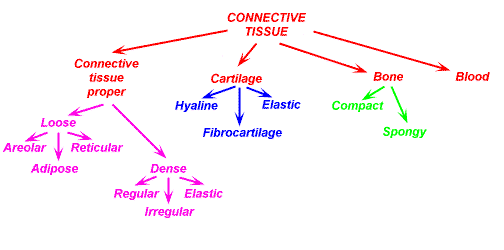
- Characteristics: Cells are loosely spaced and embedded in an intercellular matrix. It connects, supports, and binds other tissues.
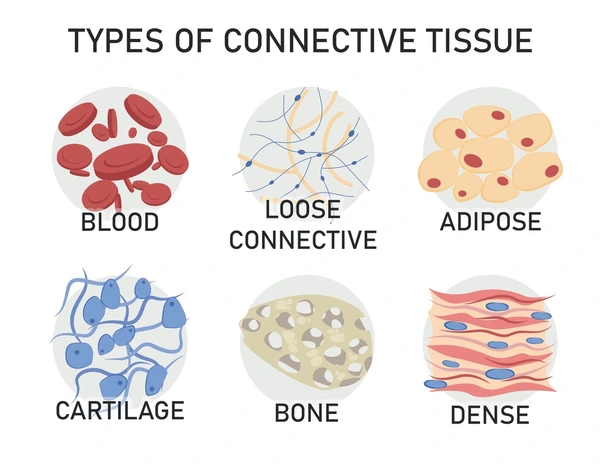
- Types:
- Blood: Fluid connective tissue. Matrix is plasma. Function: Transport of gases, nutrients, waste.
- Bone: Hard, non-flexible tissue. Matrix is rich in calcium salts. Function: Support and protection.
- Cartilage: Flexible tissue (matrix is chondrin). Found in nose, ear, larynx. Function: Provides support and flexibility.
- Ligaments: Very elastic, connect bone to bone.
- Tendons: Fibrous, less flexible, connect muscle to bone.
- Areolar Tissue: Fills space between organs. Function: Supports internal organs and helps in tissue repair.
- Adipose Tissue: Stores fat. Function: Storage, insulation.
III. Muscular Tissue
- Characteristics: Made of long, contractile cells (muscle fibres) that contain contractile proteins (actin and myosin).
- Function: Responsible for body movement and locomotion.
- Types:
- Striated (Skeletal) Muscle: Voluntary muscles, attached to bones. Long, cylindrical, unbranched, and multinucleate. Show light and dark bands (striations).
- Smooth (Unstriated) Muscle: Involuntary muscles. Found in walls of internal organs (intestine, blood vessels). Spindle-shaped, uninucleate. No striations.
- Cardiac Muscle: Involuntary muscles found only in the heart. Branched, cylindrical, uninucleate, and show faint striations. They never get tired.
IV. Nervous Tissue
- Location: Brain, spinal cord, nerves.
- Cell Type: Neurons (nerve cells).
- Structure of a Neuron:
- Cell Body (Cyton): Contains nucleus and cytoplasm.
- Dendrites: Short fibres that receive impulses.
- Axon: A single, long fibre that conducts impulses away from the cell body.
- Function: To receive, transmit, and process stimuli from the environment and within the body to coordinate responses.
Important Questions & Answers
Very Short Answer Type Questions (1 Mark)
1. Name the tissue responsible for the movement in our body.
Ans: Muscular tissue.
2. Where is apical meristem found?
Ans: At the tips of roots and stems.
3. What is the function of phloem?
Ans: To transport food (primarily sucrose) from the leaves to other parts of the plant.
4. Name the tissue that connects muscle to bone.
Ans: Tendon.
5. Which tissue makes up the husk of a coconut?
Ans: Sclerenchyma tissue.
6. What is the matrix of blood called?
Ans: Plasma.
7. Name the type of epithelium that forms the inner lining of blood vessels.
Ans: Squamous epithelium.
Short Answer Type Questions (2-3 Marks)
1. Differentiate between parenchyma, collenchyma, and sclerenchyma.
Ans:
| Feature | Parenchyma | Collenchyma | Sclerenchyma |
|---|---|---|---|
| Cell Wall | Thin-walled | Thickened at corners | Uniformly thick, lignified |
| Living/Dead | Living | Living | Dead |
| Function | Storage, Photosynthesis | Support & Flexibility | Rigid Support & Strength |
2. Write three differences between xylem and phloem.
Ans:
| Xylem | Phloem |
|---|---|
| Transports water & minerals. | Transports food (sucrose). |
| Conducts in one direction (upwards). | Conducts in both directions. |
| Main components are dead (vessels, tracheids). | Main components are living (sieve tubes). |
3. Draw a neat diagram of a neuron and label any four parts.
Ans: (Draw a neuron and label: Cell Body, Dendrites, Axon, Nerve Ending.)
4. Why are voluntary muscles also called skeletal muscles?
Ans: Voluntary muscles are called skeletal muscles because they are mostly attached to bones and help in the movement of the skeleton (bones). Their movement is under our conscious control (voluntary).
5. What are the functions of areolar tissue?
Ans: Areolar tissue:
- Fills the space inside organs.
- Supports internal organs.
- Helps in the repair of other tissues.
Long Answer Type Questions (5 Marks)
1. a) Identify the type of tissue in the following: skin, bark of tree, bone, lining of kidney tubule.
b) What are the different types of animal tissues?
Ans:
a)
- Skin: Stratified squamous epithelium (outer layer).
- Bark of tree: Cork (a protective tissue, part of the epidermis).
- Bone: Connective tissue (Skeletal connective tissue).
- Lining of kidney tubule: Cuboidal epithelium.
b) The different types of animal tissues are:
- Epithelial Tissue: For protection, secretion, absorption.
- Connective Tissue: For connection, support, transport.
- Muscular Tissue: For movement and locomotion.
- Nervous Tissue: For control and coordination.
2. a) With a diagram, describe the structure and function of cardiac muscles.
b) Why are they called involuntary muscles?
Ans:
a) Structure of Cardiac Muscles:
- Cells are cylindrical, branched, and uninucleate.
- They show faint light and dark bands (striations).
- Cells are connected by intercalated discs which allow quick transmission of impulses.
- Function: They are responsible for the rhythmic contraction and relaxation of the heart to pump blood throughout the body. They never fatigue.
b) They are called involuntary muscles because their movement is not under the conscious control of the brain. The heart beats automatically and rhythmically throughout life.
3. a) List the characteristics of meristematic tissue.
b) Explain the different types of meristem based on their location in the plant body.
Ans:
a) Characteristics of Meristematic Tissue:
- Cells are small, isodiametric, and thin-walled.
- They have a large nucleus and dense cytoplasm.
- Vacuoles are absent or very small.
- They have the power of continuous division.
b) Types of Meristem: - Apical Meristem: Present at the tips of roots and stems. It is responsible for the primary growth (increase in length) of the plant.
- Lateral Meristem (Cambium): Present on the lateral sides of roots and stems. It is responsible for the secondary growth (increase in girth or thickness) of the plant.
- Intercalary Meristem: Present at the base of leaves or internodes (e.g., in grasses). It is responsible for the growth of these regions and is also a part of the apical meristem that got separated.
Of course. Here is the study material for Class 9 Science Chapter 6: ऊतक in Hindi, perfect for revision.
अध्याय 6: ऊतक – संक्षिप्त नोट्स
1. परिचय
- ऊतक कोशिकाओं का एक समूह है जो संरचना में समान होती हैं और/या एक विशिष्ट कार्य को प्राप्त करने के लिए मिलकर काम करती हैं।
- एककोशिकीय जीव (जैसे, अमीबा) सभी कार्य एक ही कोशिका से करते हैं।
- बहुकोशिकीय जीवों में श्रम विभाजन होता है। कोशिकाओं के विभिन्न समूह (ऊतक) विभिन्न कार्यों को ग्रहण करते हैं।
2. पादप ऊतक
I. विभाज्योतकी ऊतक (Meristematic Tissue)

- विशेषताएँ: कोशिकाएँ छोटी, पतली भित्ति वाली, समव्यासिक, सघन कोशिका द्रव्य वाली, बड़े केंद्रक वाली और रिक्तिका रहित होती हैं। इनमें विभाजन की क्षमता होती है।
- स्थिति के आधार पर प्रकार:
- शीर्षस्थ विभज्योतक: जड़ों और तनों के शीर्ष पर पाया जाता है। लंबाई में वृद्धि (प्राथमिक वृद्धि) के लिए उत्तरदायी।
- पार्श्व विभज्योतक (कैंबियम): जड़ों और तनों के पार्श्व भागों में पाया जाता है। मोटाई में वृद्धि (द्वितीयक वृद्धि) के लिए उत्तरदायी।
- अंतर्वेशी विभज्योतक: पत्तियों के आधार या पर्वसन्धियों (internodes) में पाया जाता है। पत्तियों और पर्वसन्धियों की वृद्धि के लिए उत्तरदायी।
II. स्थायी ऊतक
वे कोशिकाएँ जिन्होंने विभाजन की क्षमता खो दी है और एक स्थायी आकार, आकृति और कार्य प्राप्त कर लिया है।
- A. सरल स्थायी ऊतक (एक ही प्रकार की कोशिकाओं से बना)
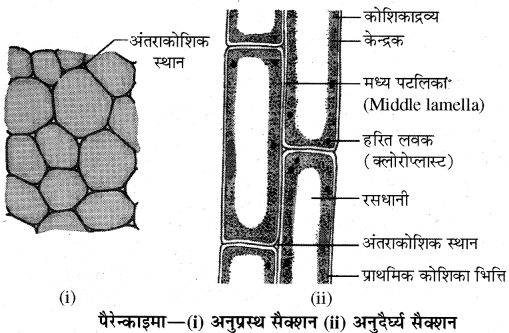
- मृदूतक (Parenchyma):
- संरचना: जीवित, पतली भित्ति वाली, ढीले पैकिंग वाली कोशिकाएँ जिनमें बड़े अंतराकोशिकीय स्थान होते हैं।
- कार्य: भंडारण, प्रकाश संश्लेषण (हरितमृदूतक), उत्प्लावन (वायुमृदूतक)।
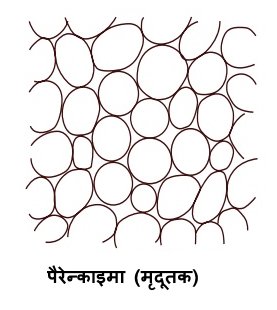
- स्थूलकोण ऊतक (Collenchyma):
- संरचना: जीवित, लंबी कोशिकाएँ जिनके कोनों पर मोटीकरण होता है। लचीलापन प्रदान करता है।
- कार्य: यांत्रिक सहारा और लचीलापन प्रदान करता है (जैसे, पत्ती के डंठल)।
- दृढ़ोतक (Sclerenchyma):
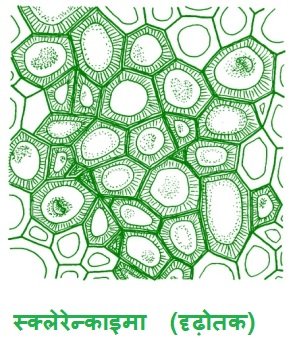
- संरचना: मृत, लंबी, संकरी कोशिकाएँ जिनकी मोटी, लिग्निनयुक्त भित्तियाँ होती हैं। कोई अंतराकोशिकीय स्थान नहीं होता।
- कार्य: पादप को कठोर यांत्रिक सहारा और मजबूती प्रदान करता है।
- B. जटिल स्थायी ऊतक (एक से अधिक प्रकार की कोशिकाओं से बना; संवहनी ऊतक)
- जाइलम:
- कार्य: जड़ों से पानी और खनिजों का संवहन पौधे के अन्य भागों तक करता है।
- घटक: वाहिनिका, वाहिका, जाइलम मृदूतक, जाइलम तंतु।
- फ्लोएम:
- कार्य: पत्तियों से भोजन (सुक्रोज) का संवहन पौधे के अन्य भागों तक करता है।
- घटक: चालनी नलिका, सहचर कोशिका, फ्लोएम मृदूतक, फ्लोएम तंतु।
3. जंतु ऊतक
I. उपकला ऊतक (Epithelial Tissue)
- विशेषताएँ: शरीर की सतह को ढकता और सुरक्षा करता है, शरीर की गुहाओं और अंगों को अस्तर प्रदान करता है। कोशिकाएँ सघन रूप से संकुलित होती हैं, अंतराकोशिकीय पदार्थ बहुत कम होता है।
- प्रकार:
- शल्की उपकला: चपटी, टाइल जैसी कोशिकाएँ। त्वचा, मुख गुहा, रक्त वाहिकाओं में पाई जाती हैं (प्रसार के लिए पतली परत बनाती हैं)।
- घनाकार उपकला: घनाकार कोशिकाएँ। वृक्क नलिकाओं, लार ग्रंथियों में पाई जाती हैं (स्राव और अवशोषण के लिए)।
- स्तम्भी उपकला: स्तंभ जैसी कोशिकाएँ। आंत की अंदरूनी परत में पाई जाती हैं (स्राव और अवशोषण के लिए)।
- पक्ष्माभी उपकला: पक्ष्म (सिलिया) युक्त स्तम्भी कोशिकाएँ। श्वसन मार्ग में पाई जाती हैं (बलगम को हटाने के लिए)।
- ग्रंथिल उपकला: रूपांतरित स्तम्भी कोशिकाएँ जो ग्रंथियाँ बनाती हैं (स्राव के लिए)।
II. संयोजी ऊतक (Connective Tissue)
- विशेषताएँ: कोशिकाएँ ढीले पैकिंग वाली होती हैं और एक अंतराकोशिकीय आधात्री (matrix) में सन्निहित होती हैं। यह अन्य ऊतकों को जोड़ता, सहारा देता और बांधता है।
- प्रकार:
- रक्त: तरल संयोजी ऊतक। आधात्री प्लाज्मा है। कार्य: गैसों, पोषक तत्वों, अपशिष्टों का परिवहन।
- हड्डी: कठोर, अनम्य ऊतक। आधात्री कैल्शियम लवणों से भरपूर। कार्य: सहारा और सुरक्षा।
- उपास्थि (Cartilage): लचीला ऊतक (आधात्री कॉन्ड्रिन है)। नाक, कान, स्वरयंत्र में पाया जाता है। कार्य: सहारा और लचीलापन प्रदान करता है।
- स्नायु (Ligaments): बहुत लचीले, हड्डी को हड्डी से जोड़ते हैं।
- कंडरा (Tendons): रेशेदार, कम लचीले, मांसपेशी को हड्डी से जोड़ते हैं।
- अंतरालीय ऊतक (Areolar Tissue): अंगों के बीच के स्थान को भरता है। कार्य: आंतरिक अंगों को सहारा देता है और ऊतक मरम्मत में helps करता है।
- वसीय ऊतक (Adipose Tissue): वसा का भंडारण करता है। कार्य: भंडारण, इन्सुलेशन।
III. पेशीय ऊतक (Muscular Tissue)
- विशेषताएँ: लंबी, संकुचनशील कोशिकाओं (पेशी तंतुओं) से बना होता है जिनमें संकुचनशील प्रोटीन (एक्टिन और मायोसिन) होते हैं।
- कार्य: शरीर की गति और गमन के लिए उत्तरदायी।
- प्रकार:
- रेखित (कंकाल) पेशी: ऐच्छिक पेशियाँ, हड्डियों से जुड़ी होती हैं। लंबी, बेलनाकार, अशाखित और बहुकेंद्रकी। हल्के और गहरे बैंड (रीझ) दिखाई देते हैं।
- अरेखित (चिकनी) पेशी: अनैच्छिक पेशियाँ। आंतरिक अंगों (आंत, रक्त वाहिकाओं) की दीवारों में पाई जाती हैं। तर्कुरूप, एककेंद्रकी। कोई रीझ नहीं होती।
- हृदय पेशी: अनैच्छिक पेशियाँ जो केवल हृदय में पाई जाती हैं। शाखित, बेलनाकार, एककेंद्रकी और हल्की रीझ दिखाई देती हैं। ये कभी नहीं थकतीं।
IV. तंत्रिका ऊतक (Nervous Tissue)
- स्थान: मस्तिष्क, मेरुरज्जु, तंत्रिकाएँ।
- कोशिका प्रकार: न्यूरॉन (तंत्रिका कोशिका)।
- न्यूरॉन की संरचना:
- कोशिका काय (साइटॉन): इसमें केंद्रक और कोशिका द्रव्य होता है।
- द्रुमिकाएँ (Dendrites): छोटे तंतु जो आवेगों को ग्रहण करते हैं।
- एक्सॉन: एक लंबा तंतु जो आवेगों को कोशिका काय से दूर संचालित करता है।
- कार्य: पर्यावरण और शरीर के भीतर से उद्दीपनों को प्राप्त, संचालित और संसाधित करना ताकि प्रतिक्रियाओं का समन्वय किया जा सके।
महत्वपूर्ण प्रश्न एवं उत्तर
अति लघु उत्तरीय प्रश्न (1 अंक)
1. हमारे शरीर में गति के लिए उत्तरदायी ऊतक का नाम बताइए।
उत्तर: पेशीय ऊतक।
2. शीर्षस्थ विभज्योतक कहाँ पाया जाता है?
उत्तर: जड़ों और तनों के शीर्ष पर।
3. फ्लोएम का कार्य क्या है?
उत्तर: पत्तियों से भोजन (मुख्यतः सुक्रोज) का संवहन पौधे के अन्य भागों तक करना।
4. उस ऊतक का नाम बताइए जो मांसपेशी को हड्डी से जोड़ता है।
उत्तर: कंडरा (Tendon)।
5. नारियल का छिलका किस ऊतक से बना होता है?
उत्तर: दृढ़ोतक (Sclerenchyma)।
6. रक्त के आधात्री को क्या कहते हैं?
उत्तर: प्लाज्मा।
7. उस उपकला का नाम बताइए जो रक्त वाहिकाओं की आंतरिक परत बनाती है।
उत्तर: शल्की उपकला।
लघु उत्तरीय प्रश्न (2-3 अंक)
1. मृदूतक, स्थूलकोण ऊतक और दृढ़ोतक में अंतर स्पष्ट कीजिए।
उत्तर:
| लक्षण | मृदूतक | स्थूलकोण ऊतक | दृढ़ोतक |
|---|---|---|---|
| कोशिका भित्ति | पतली भित्ति | कोनों पर मोटी | एक समान मोटी, लिग्निनयुक्त |
| जीवित/मृत | जीवित | जीवित | मृत |
| कार्य | भंडारण, प्रकाश संश्लेषण | सहारा व लचीलापन | दृढ़ सहारा व मजबूती |
2. जाइलम और फ्लोएम के बीच तीन अंतर लिखिए।
उत्तर:
| जाइलम | फ्लोएम |
|---|---|
| जल और खनिजों का परिवहन करता है। | भोजन (सुक्रोज) का परिवहन करता है। |
| एक दिशा में संवहन करता है (ऊपर की ओर)। | दोनों दिशाओं में संवहन करता है। |
| मुख्य घटक मृत होते हैं (वाहिका, वाहिनिका)। | मुख्य घटक जीवित होते हैं (चालनी नलिका)। |
3. एक न्यूरॉन का स्वच्छ नामांकित चित्र बनाइए और इसके कोई चार भागों के नाम लिखिए।
उत्तर: (एक न्यूरॉन बनाएं और लेबल करें: कोशिका काय, द्रुमिकाएँ, एक्सॉन, तंत्रिका अंत।)
4. ऐच्छिक पेशियों को कंकालीय पेशियाँ क्यों कहा जाता है?
उत्तर: ऐच्छिक पेशियों को कंकालीय पेशियाँ इसलिए कहा जाता है क्योंकि ये ज्यादातर हड्डियों से जुड़ी होती हैं और कंकाल (हड्डियों) की गति में helps करती हैं। इनकी गति हमारे conscious control (इच्छा) में होती है।
5. अंतरालीय ऊतक के कार्य क्या हैं?
उत्तर: अंतरालीय ऊतक:
- अंगों के बीच के स्थान को भरता है।
- आंतरिक अंगों को सहारा देता है।
- अन्य ऊतकों की मरम्मत में helps करता है।
दीर्घ उत्तरीय प्रश्न (5 अंक)
1. a) निम्नलिखित में ऊतक के प्रकार की पहचान कीजिए: त्वचा, वृक्ष की छाल, हड्डी, वृक्क नलिका की अस्तर।
b) जंतु ऊतक के विभिन्न प्रकार कौन-कौन से हैं?
उत्तर:
a)
- त्वचा: स्तरित शल्की उपकला (बाहरी परत)।
- वृक्ष की छाल: कॉर्क (एक सुरक्षात्मक ऊतक, एपिडर्मिस का भाग)।
- हड्डी: संयोजी ऊतक (कंकाल संयोजी ऊतक)।
- वृक्क नलिका की अस्तर: घनाकार उपकला।
b) जंतु ऊतक के विभिन्न प्रकार हैं:
- उपकला ऊतक: सुरक्षा, स्राव, अवशोषण के लिए।
- संयोजी ऊतक: जोड़ने, सहारा देने, परिवहन के लिए।
- पेशीय ऊतक: गति और गमन के लिए।
- तंत्रिका ऊतक: नियंत्रण और समन्वय के लिए।
2. a) हृदय पेशियों की संरचना और कार्य का वर्णन चित्र सहित कीजिए।
b) उन्हें अनैच्छिक पेशियाँ क्यों कहा जाता है?
उत्तर:
a) हृदय पेशियों की संरचना:
- कोशिकाएँ बेलनाकार, शाखित और एककेंद्रकी होती हैं।
- इनमें हल्के और गहरे बैंड (रीझ) दिखाई देते हैं।
- कोशिकाएँ अंतर्विष्ट चक्रिकाओं (intercalated discs) द्वारा जुड़ी होती हैं जो आवेगों के तीव्र संचरण में helps करती हैं।
- कार्य: ये हृदय की लयबद्ध संकुचन और शिथिलन के लिए उत्तरदायी हैं ताकि पूरे शरीर में रक्त पंप किया जा सके। ये कभी नहीं थकतीं।
b) उन्हें अनैच्छिक पेशियाँ इसलिए कहा जाता है क्योंकि उनकी गति मस्तिष्क के conscious control (इच्छा) में नहीं होती। हृदय जीवन भर स्वतः और लयबद्ध रूप से धड़कता रहता है।
3. a) विभाज्योतकी ऊतक की विशेषताएँ लिखिए।
b) पादप शरीर में उनकी स्थिति के आधार पर विभिन्न प्रकार के विभज्योतक को समझाइए।
उत्तर:
a) विभाज्योतकी ऊतक की विशेषताएँ:
- कोशिकाएँ छोटी, समव्यासिक और पतली भित्ति वाली होती हैं।
- इनमें बड़ा केंद्रक और सघन कोशिका द्रव्य होता है।
- रिक्तिकाएँ अनुपस्थित या बहुत छोटी होती हैं।
- इनमें निरंतर विभाजन की क्षमता होती है।
b) विभज्योतक के प्रकार: - शीर्षस्थ विभज्योतक: जड़ों और तनों के शीर्ष पर पाया जाता है। यह पौधे की प्राथमिक वृद्धि (लंबाई में वृद्धि) के लिए उत्तरदायी है।
- पार्श्व विभज्योतक (कैंबियम): जड़ों और तनों के पार्श्व भागों में पाया जाता है। यह पौधे की द्वितीयक वृद्धि (मोटाई या परिधि में वृद्धि) के लिए उत्तरदायी है।
- अंतर्वेशी विभज्योतक: पत्तियों के आधार या पर्वसन्धियों (जैसे, घास में) में पाया जाता है। यह इन क्षेत्रों की वृद्धि के लिए उत्तरदायी है और शीर्षस्थ विभज्योतक का ही एक अलग हुआ भाग होता है।
